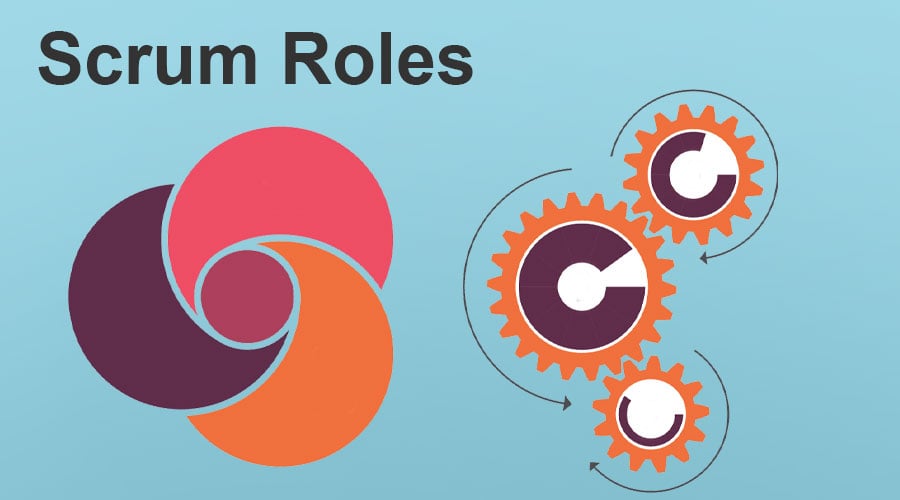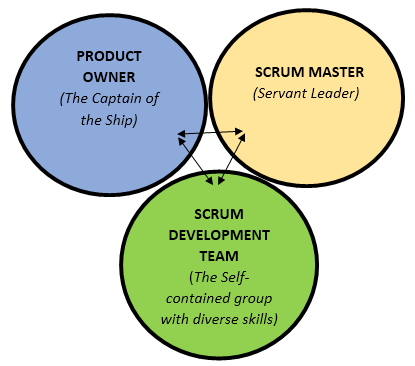
Introduction to Scrum Roles
Scrum Roles is within Scrum Methodology; Scrum Management does the end product delivered to the customers. This Scrum Management consists of Scrum Roles. Unlike conventional project management, ‘Scrum Roles’ function differently. Primarily, there are 3 main roles in Scrum:
- Product Owner,
- Scrum Master &
- Scrum/Development Team
“Scrum Roles can be defined as a set of individuals entitled to execute task-related responsibilities in sync with one another to make a project successful”.
Roles of Scrum
Scrum Role Anatomy, as represented above, indicates the collaborative sync of responsibilities carried out by the Product Owner, Scrum Master & Scrum Development Team to attain the project objectives.
1. Product Owner (PO)
The pivotal role in scrum management is that of a ‘Product Owner’. He/She is accountable for the success or failure of a project. The Product Owner sets the project vision/goals, defines and prioritizes the project tasks and provides expert guidance throughout the execution of a project. Additionally, acting as an intermediary, the Product Owner communicates the interests or requirements of the external stakeholders/customers to the Scrum team.
However, the Product Owner does not micro-manage a team but has to continually ensure that the work done aligns with the project targets. Product Owner is authorized to modify the project scope, revise and manage the product backlog so as to maximize the ROI (Return On Investment),
Job Responsibilities of the Product Owner (PO) in Scrum Roles:
The Job responsibility of the product owner in scrum roles are as follows:
a. Intermediary between the internal & external stakeholders
The PO is a mediator between the internal and external stakeholders. It is the responsibility of the PO to gather feedback about the needs/expectations of the internal stakeholders/customers. The product development team has to be updated about these inputs so as to design the product accordingly. Lack of collaboration and engagement with the team members can lead to project failure.
b. Management of Product Backlog
The PO has to develop, revise and manage the Product Backlog as per the internal stakeholder requirements. He/She has to ensure that the items in the product backlog are altered continually as required to meet the competitive expectations. The scrum team is conveyed about the same, enabling collaborative working to deliver high-value results. PO has to remain answerable at all times to the queries raised by the team.
c. Certification of a Product
Another key role of the PO is to certify the product upon meeting the quality standards as defined in the ‘Acceptance//Required Criteria’. Therefore, PO has to ensure that after every sprint, the developed product features undergo the ‘Acceptance/Quality Assessments’ so as to align with the ‘Required Criteria’. This enables to continually upgrade and deliver a product with zero errors.
2. Scrum Master (SM)
Considered as the ‘Servant Leader’, the Scrum Master is the trainer, facilitator, and defender of the Scrum Team. SM trains the team members on scrum practices and ensures that the team adheres to the values and principles of Scrum. In addition, the SM has to facilitate communication and collaboration within the team and keep them motivated about the work.
Though the SM does not exhibit any authority over the project, he/she is authorized to manage the process. SM assists the PO and safeguards the team from any obstacles/hurdles in the way of attaining project goals.
Job Responsibilities of the Scrum Master in Scrum Roles:
The Job responsibility of the scrum master in Scrum roles are as follows:
a. Facilitation of Process Improvement
SM, in collaboration with the team, works on improvising the Scrum practices to deliver maximum value. In addition, he plays the role of an enabler to the team by removing any obstacles and making the sprint goals attainable.
b. Training the Scrum Team
SM plays the role of a mentor/trainer and coaches the team on the practices of Scrum. He/She also ensures that there is proper co-ordination between the PO and the team. For example, if the PO cannot give adequate time to the team, SM has to guide the importance of the same to the PO and make sure the team is successful.
c. Safeguard the Team and Remove Barriers
SM has to address and remove barriers, if any, that can adversely affect team performance. He/She has to come up with solutions on any issues that the team cannot handle to prevent it from delivering good business. While several scrum teams are working together, SM also has to safeguard the teams from any interference and make sure they focus on delivering value during every sprint cycle.
3. Scrum Development Team
A scrum team is a multi-skilled unit of members consisting of product developers and testers with varied skill-sets in their own area of specialization. The self-contained team with diverse expertise is responsible for creating, assessing and upgrading the product after every sprint to deliver end results of high value.
If new expertise is required, the team has the authority to develop or include a new member with the required skill-set.
Job Responsibilities of the Scrum Development Team in Scrum Roles:
The Job responsibility of the scrum development team in scrum roles are as follows:
a. Development of Product
The Scrum team is responsible for developing and upgrading the product after every sprint cycle, based on the listed items in the Product Backlog. In addition, the team must ensure that the product increments meet the desired quality standards and are defect-free. This enables to deliver the business value of high grade and set standards so as to make the project successful.
b. Create tasks and provide estimates
During the sprint review meetings, the team is responsible for selecting items from the backlog based on priority, which is to be delivered in the upcoming Sprint. Therefore, they contribute to the creation of ‘Sprint Backlogs’. The team also plays a key role in creating tasks by segregating Sprint items and approximation to these sprint items.
Thus, the scrum team is required to independently work on the tasks and ensure the timely completion of every sprint cycle.
The above-mentioned 3 roles are fundamental to deliver scrum success and work in sync with one another.
Recommended Articles
This has been a guide to Scrum Roles. Here we discussed the Concept and some of the leading roles of Scrum with their Job Responsibilities. You can also go through our other Suggested Articles to learn more –

